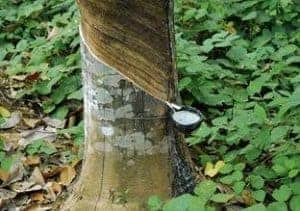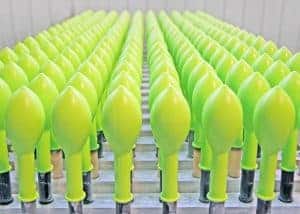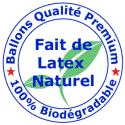How Natural Latex Balloons Are Made
At CSA Balloons, we print over 5 million balloons per year. We intentionally chose to print only on 100% Natural Latex balloons, or Mylar balloons (which are 100% recyclable).
Let’s look at how natural latex balloons are made.
Types of Rubber Balloons
Before getting into details, it’s important to understand that there are more than one way to make rubber.
Balloons have come a long way from their original form. Historically, balloons were made of animal bladders or intestines. Now, they are made of rubber, natural or synthetic.
Synthetic Rubber Balloons
Synthetic rubber balloons are made of neoprene and are specially designed for overall superior resistance. They are therefore used for specific purposes, such as meteorological probes (known as weather balloons), as well as for muscle and training equipment. Since they are not a source of concern for people allergic to latex, they are also often used as medical equipment.
Natural Rubber Balloons
In contrast with other latex products that are made of synthetic polymers, natural rubber balloons are made of sap naturally extracted from the Hevea (rubber) tree. Incredibly flexible and expandable (stretching 7 to 8 times its length and returning to its original shape), natural rubber balloons are also 100 percent biodegradable, the degradation process beginning right after the balloon is manufactured.
Natural Latex Balloon Manufacturing
 Latex balloons are made from a combination of organic compounds and water. The latex –a milky sap that comes from the Hevea tree, is a renewable resource that can be sustainably tapped without harming the tree. The latex is accumulated in buckets, dripping from cuts in the bark that are no harm to the tree. The process is much like that used to collect maple syrup.
Latex balloons are made from a combination of organic compounds and water. The latex –a milky sap that comes from the Hevea tree, is a renewable resource that can be sustainably tapped without harming the tree. The latex is accumulated in buckets, dripping from cuts in the bark that are no harm to the tree. The process is much like that used to collect maple syrup.
The 7 Steps to Make Natural, Beautiful Balloons
Essentially, the process of manufacturing natural latex balloons entails dipping a mold into the latex. The mold is shaped as a deflated balloon. Colored balloons are made by mixing a pigment into the latex prior to manufacturing.

- The latex is first poured into temperature controlled tanks, where stirring mechanisms ensure the latex does not settle.
- The molds are immersed in a tank of coagulant (mix of water, a calcium-based salt, soap, and talc powder) and then heated.
- The molds are then immersed in the latex tank.
- The lip is formed on the neck of the balloon by rolling the edge with a brush or a roller.
- The molds are then immersed in plain water to remove excess coagulant.
- The latex balloons are then dried and cured –usually being placed in an oven for approximately 1 hour
- Finally, the balloons are then mechanically removed from the molds (using a spray of water or air), dried in large tumble dryers, and packaged.
The process to making natural latex balloons is simple and without the use of harsh chemical products, which makes them 100% biodegradable.
For more information on how 100% Natural Latex Balloons are custom printed, watch our video.






